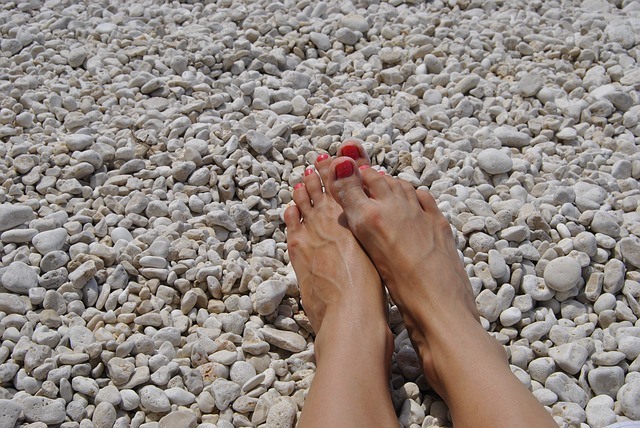Toenail fungus (or onychomycosis, as it’s known in medical terms) happens when invading fungus settles on or around your nail and begins to grow.
Because this fungus is a foreign substance that has taken residence, your body’s immune system is in charge of combatting it. However, if your immune system is weak, then the infection will have free reign to take over the nail.
What should you look out for, and how can you fix it? Let’s find out.

Contents
Types of Toenail Fungus
Dermatophytes
This is the same fungal infection that causes athlete’s foot. It grows on the skin of your feet, particularly between your toes.
You can get infected with dermatophytes by coming into contact with an object that has it, such as nail clippers, nail files, shoes, and even the floor.
Yeast
Yeast is a type of fungus that is natural on the body. However, hormonal imbalances can cause an overgrowth of yeast, which eventually leads to a yeast infection that can affect the nails.
What Are the Symptoms of Toenail Fungus?
Thick Toenails
When you get a fungal infection, it invades the nail bed and causes your nails to grow thicker.
Colored Spots or Lines Running Along the Nail
The fungus that invades will become more visible as it grows and will take the form of either black, green, or yellow spots and lines on your nail.
A Strange Odor Coming From the Nail
Because fungus works like bacteria when it invades your body, it can cause unpleasant odors from the affected nail.
Brittle Nails
The fungus can break apart the cells in your nails, causing them to grow brittle.
Nails Falling Off (in Extreme Cases)
If gone untreated for a long time, the fungal infection can lift your nail from the skin and make it fall off.
It can also rot the nail to a point where the body rejects it and pushes it out.
What CausesToenail Fungus?
Coming Into Contact With Infected Items or Bacteria
Touching fungus-infected items such as clothes and shoes can spread the infection.
Touching bacteria, in general, can also lead to infection, as the bacteria can settle into your nail just as easily as normal fungus.

Getting Nail Injuries
Injuries can debilitate the nail, making it softer. This allows the fungus to get under the weak nail much more easily.
Having Diabetes, Being Obese, or Having Circulation Problems
Circulation problems can be a side effect of diabetes and obesity, and poor circulation causes infection.
Having a Weak Immune System and Being Over the Age of 60
Our immune system is what fights off fungal infection, but as we grow older, our immune system gets weaker.
How to Prevent Toenail Fungus
- Avoid pedicures at nail salons. It’s very easy to come in contact with items that have been infected by another customer, so either avoid pedicures completely or learn how to do them yourself at home.
- Always make sure your feet are dry after taking a shower before you put on shoes.
- Always keep your nails trimmed and short.
- Take vitamins and supplements to keep your immune system up.
- Wear sandals and other open shoes when it’s hot. We sweat a lot during hot climate, and that sweat can cause fungal growth on our humid feet.
What to Do If You Already Have Toenail Fungus
If you have toenail fungus, go to a doctor. They will most likely prescribe oral medicine like fluconazole to help, but in most cases, the infection will return after a few months.
The most common type of fungal infection, distal subungual onychomycosis, can be very difficult to treat.
How Can I Treat Toenail Fungus at Home?
You can treat toenail fungus at home, but you should only use them if your infection is minimal, since fungus infections can be hard to get rid of and most cases require professional attention.
Tea Tree Oil or Lavender Oil
These have antiseptic properties and are used to treat athlete’s foot.
Apply the oil directly on the infected nail with a cotton swab and let it sit for 10-15 minutes before wiping it off.
Repeat daily until the infection clears.
Vinegar Soak
Soak your feet in a hot water and vinegar mix for 10-15 minutes.
Repeat twice a day, two to four times a week until the infection clears.
Garlic and Vinegar
Mix crushed garlic or garlic oil and vinegar to create a powerful antifungal solution.
You can either soak your feet in the solution or wrap a solution-soaked cloth around the infected area.
Repeat for 20-30 minutes, three to four times a week until the infection clears.
Lemon
Lemon is a strong acidic citrus that disinfects areas with bacteria.
Apply lemon juice to the infected area for 30 minutes daily until the infection clears.

Listerine
Easy to acquire and highly effective because of the bacteria-removing properties, one of the most popular home remedies to treat toenail fungus is Listerine.
Soak your feet in Listerine for 25-30 minutes daily.
Baking Soda
We use baking soda to get rid of mold in our house; we can use it for our feet too!
Mix water and baking soda to create a paste that kills fungus and eliminates odor.
Apply the paste on the infected nail for 10-15 minutes. Repeat daily.
Bleach
Pour water into a basin and add one tablespoon of bleach.
Make sure it is completely diluted to avoid burning yourself with the bleach.
Soak your feet in for 20-30 minutes daily.
Over the Counter Remedies
If you’re not into DIY solutions, you can always buy effective toenail fungus cream, such as Fulvicin, Sporanox, and Lamisil, and still treat yourself at home.
Do you have any tips on treating toenail fungus?

